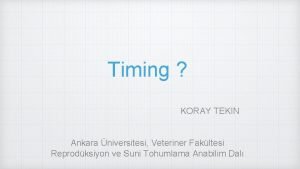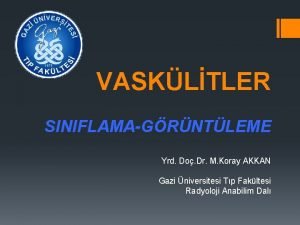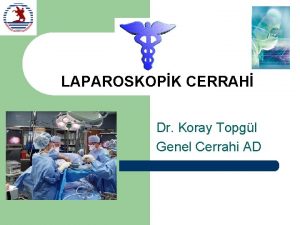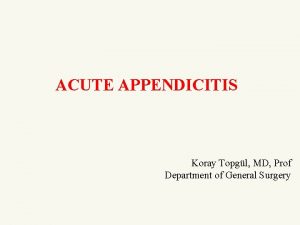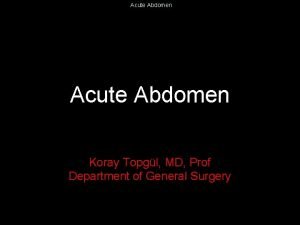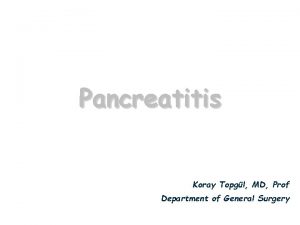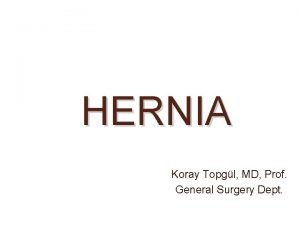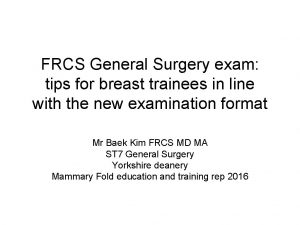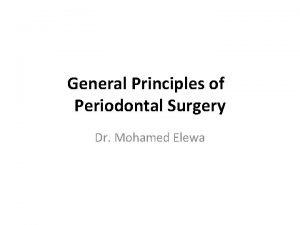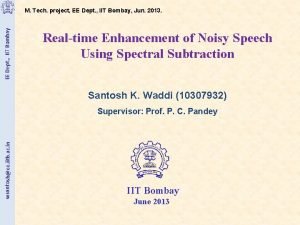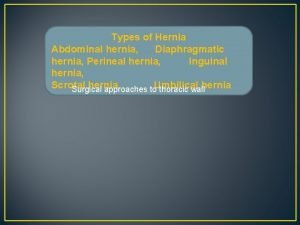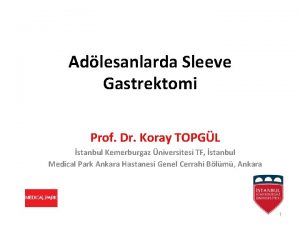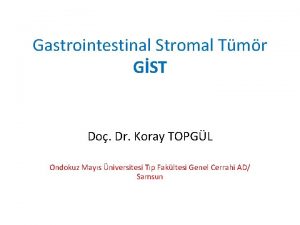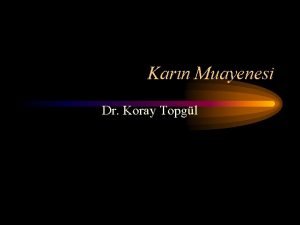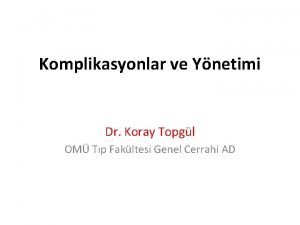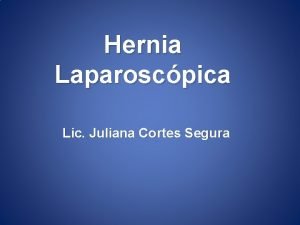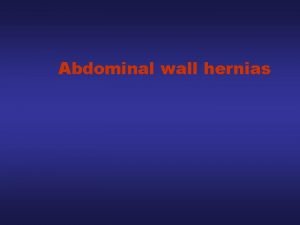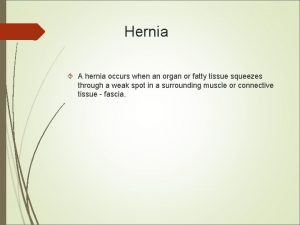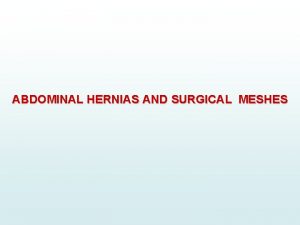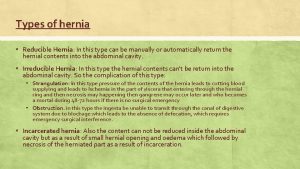HERNIA Koray Topgl MD Prof General Surgery Dept






































- Slides: 38

HERNIA Koray Topgül, MD, Prof. General Surgery Dept.

Definition A hernia is a protrusion of a viscus or part of a viscus through an abnormal opening in the walls of its containing cavity.

Common Hernia • Umbilical • Incisional • Inguinal – Direct and indirect • Femoral


Anatomy The inguinal canal : - The inguinal canal is approximately 4 cm long and is 4 cm long directed obliquely inferomedially through the inferomedially inferior part of the anterolateral abdominal wall. The canal lies parallel and 2 -4 cm superior to the medial half of the inguinal ligament. This ligament extends from the anterior superior iliac spine to the pubic tubercle.

The inguinal canal has openings at either end : The deep (internal) inguinal ring is the entrance to The deep (internal) inguinal ring the inguinal canal. It is thesite of an outpouching of the transversalis fascia. This is approximately 1. 25 cm superior to the middle of the inguinal ligament The superficial, or external inguinal ring is the exit The superficial, or external inguinal from the inguinal canal. It is a slitlke opening between the diagonal fibres of the aponeurosis of the external oblique

Inguinal canal Walls of the inguinal canal : The anterior wall is formed mainly by the aponeurosis of the external Oblique The posterior wall is formed mainly by transversalis fascia The roof is formed by the arching fibres of the internal oblique and transverse abdominal muscles. transverse abdominal The floor is formed by the inguinal ligament, which forms a shallow trough. It is reinforced in its most medial part by the lacunar ligament.


Groin Anatomy--Anterior • • Inguinal ligament Layers External ring Internal ring Spermatic cord Inferior epigastrics Hesselbach’s triangle • Femoral vessels

Groin Anatomy--Posterior

Transperitoneal Anatomy

Content : 1. Spermatic cord ( round ligament of the uterus in female ) Spermatic cord The Cord Itself. —The contents of the spermatic cord are (a) the ductus (vas) deferens and its artery. (b) the testicular artery and venous (pampiniform) plexus. (c) the genital branch of the genitofemoral nerve. (d) lymphatic vessels and sympathetic nerve fibers. (e) fat and connective tissue surrounding the cord and its coverings in various amounts 2. Ilioinguinal nerve 3. Ilioinguinal lymph node

Femoral Canal Contains, from lateral to medial, the femoral artery, femoral vein, and femoral canal. Other features of the femoral triangle include the femoral nerve, which lies lateral to the sheath, Wall of The Femoral canal Anterior is the inguinal ligament Posterior is the iliopsoas, pectineal, and long adductor muscles (floor). Medial is lacunar ligament Lateral is femoral vessle

Predisposing: All hernias occur at the site of WEAKNESS OF THE ABDOMINAL WALL which are acted on by repeated INCREASE in abdominal pressure


• Indirect Inguinal Hernia through the inguinal canal (Lateral Hernia) • Direct Inguinal Hernia The sac passes through a weakness or defect of the transversalis fascia in the posterior wall of the inguinal canal-Hasselbach triangle. . (Medial Hernia) • Femoral Hernia medial to femoral vessels under inguinal ligament • Umbilical Hernia through the umbilical ring

Paraumbilical Hernia A protrusion through the linea alba just above or sometimes just below the umbilicus Epigastric Hernia Protrusion of extraperitoneal fat through the linea alba anywhere between the xiphoid process and the umbilicus Incisional Hernia through an incisional site an incisional Lumber Hernia occur through the inferior lumber triangle of Petit

Repeated INCREASE in abdominal pressure is usually due to Chronic cough Straining Bladder neck or urethral obstruction Pregnancy Vomiting Sever muscular effort Ascetic fluid

Inguinal hernia History: 1. Age (young vs. old) 2. Occupation ( nature ? ? ) 3. Local symptoms: Swelling, discomfort and pain 4. Systemic symptoms: if there is obstruction or strangulation 5. Precipitating factors

Pertinent Exam • • Location Reducible? (incarcerated=irreductible) Tender? Skin changes? Palpable edges Genitalia Rectal

Inguinal hernia Examination: 1. Inspection for site, size, shape and color. 2. Palpation for surface, temp, tenderness, composition and reducibility. 3. Expansible cough impulse. 4. General exam: for common causes of increase intra abdominal pressure

Indirect Versus Direct inguinal hernias Indirect is the most common form of hernia and its usually congenital due to congenital patent processus vaginalis Direct usually acquired occur in old men with weak abdominal muscles. weak abdominal

Indirect Versus Direct inguinal hernias Indirect Inguinal Hernia Direct Inguinal Hernia Pass through inguinal canal. Bulge from the posterior wall of the inguinal canal Can descend into the scrotum. Cannot descent into the scrotum. Lateral to inferior epigastric vessels. Medial to inferior epigastric vessels. Reduced: upward, then laterally and backward. Reduced: upward, then straight backward. Controlled: after reduction by pressure over the internal (deep) inguinal ring. Not controlled: after reduction by pressure over the internal (deep) inguinal ring. The defect is not palpable (it is behind the The defect may be felt in the abdominal wall fibers of the external oblique muscle). above the pubic tubercle. After reduction: the bulge appears in the middle of inguinal region and then flows medially before turning down to the scrotum. After reduction: the bulge reappears exactly where it was before. Common in children and young adults. Common in old age.

Femoral hernia Small femoral hernia may be unnoticed by the patient or disregarded for years perhaps until the day it strangulates. Adherence of the greater omentum sometimes causes a dragging pain. Rarely a large sac is present.

Femoral hernia History Age ; uncommon in children , most common in old age female. Sex; women > men (but still commonest hernia in women the inguinal hernia ) The patient came with local symptoms 1 - discomfort and pain 2 - swelling in the groin General ; femoral hernia is more likely to be strangulated than the inguinal hernia Multiplicity ; often bilateral

Femoral hernia versus inguinal hernia Inguinal hernia Femoral hernia 1 - more common in male 1 - more common in females 2 - pass through the inguinal canal 2 - pass through the femoral canal 3 - less common to be strangulated 4 - more common to be strangulated 4 - can be treated without surgery 5 - must be treated surgically

Umbilical Hernia through the umbilical scar , so it is a true umbilical hernia. Not common and is usually secondary to increase intra abdominal pressure. The most common causes 1 - pregnancy 2 - ascitis 3 - ovarian cyst 4 - fibrosis 5 - bowel distention

Incision hernia Signs and symptoms Previous operation or accidental trauma Age ; all ages , but more common in old age. Symptom ; lump , pain , intestinal obstruction ( distention , colic, vomiting , constipation , sever pain in the lump ) Examination 1 - reducible lump 2 - expansile cough impulse 3 - if the lump dose not reduse and dose not have cough impulse , than it may be not a hernia Ddx Tumor Chronic abscess Hematoma Foreign body granuloma

Etiology of Incisional Hernia Patient-related factors—DM, Obesity, Smoke, Chronic Patient-related factors obstructive pulmonary disease, multiple surgery, cancer, chemotherapy, radiotherapy, malnutrition, jaundice, CRF. . Technical factors---bad surgical technique, wrong echnical factors surgical materials Mechanical factors---Mechanical factors increase the Mechanical factors intra-abdominal pressure after an operation and causes the hernia. Common causes include-

Chronic cough- Coughing and vomiting are associated with a brief but significant increase in intra-abdominal pressure. This, again, leads to too much tension on the incision and possible breakdown of the incision. Lifting heavy weights- Obviously, if a patient lifts something too heavy immediately after the operation, he or she can also tear the incision and cause a hernia. Postoperative ileus- This occurs when the abdomen becomes distended because the intestines are not working properly after an operation. The swelling of the intestines increases the pressure in the abdomen and places tension on the incision. The tension then leads to defective healing. Constipation-Straining to move bowels after surgery

Management and Repair

Reduction Uncomplicated: Manual Gentle pressure over hernia Gentle traction over the mass sedation Complicated (strangulated): no attempt!! should be made to reduce the hernia because of potential reduction of gangrenous segment of bowel with the hernial sac.

Surgical Treatment 1. choice of anesthetic: Elective open repair : Local/Spinal anesthesia is preferred Laproscopic hernia repair: more commonly under GA.

Inguinal Floor Reconstruction 3. Inguinal Floor Reconstruction Some method of reconstruction of the inguinal floor is necessary in all adult hernia repairs to prevent recurrence. Primary tissue repair Open tension free repair Laproscopic & preperitoneal repairs

1. Primary tissue repair Bassini repair: inferior arch of transversalis fascia (TF) or conjoint tendon is approximated to shelving portion of inguinal ligament. Mc. Vay: TF is sutured to cooper ligament. Shouldice: TF is incised and reapproximated.

Shouldice Repair • Imbricated, running repair

2. Open tension free repair Lichtenstein repair &Patch and Plug technique: Mesh is used to reconstruct inguinal floor Mesh plug technique : place mesh in the hernial defect

Mesh repair • Tension free • Less painful • Foreign body
 Lockwood low operation
Lockwood low operation Koray tekin
Koray tekin Koray göksal
Koray göksal Koray akkan
Koray akkan Topgl
Topgl Topgl
Topgl Acute appendicitis
Acute appendicitis Peritonitis
Peritonitis Steatorrhea pictures
Steatorrhea pictures Spermatic cord mnemonic
Spermatic cord mnemonic Murphy bulgusu
Murphy bulgusu Frcs viva
Frcs viva General surgery selection criteria
General surgery selection criteria General principles of periodontal surgery
General principles of periodontal surgery Dept. name of organization
Dept. name of organization La dept of revenue
La dept of revenue Nebraska dept of agriculture
Nebraska dept of agriculture Dept a
Dept a Gome dept
Gome dept Dept. name of organization
Dept. name of organization Dept c13 nmr
Dept c13 nmr Hoe dept
Hoe dept Dept of education
Dept of education Ohio dept of dd
Ohio dept of dd Florida department of agriculture and consumer services
Florida department of agriculture and consumer services Geaux biz login
Geaux biz login Ee dept iitb
Ee dept iitb Dept nmr spectroscopy
Dept nmr spectroscopy Central islip fire dept
Central islip fire dept Gome dept
Gome dept Mn dept of education
Mn dept of education Pt dept logistik
Pt dept logistik Florida dept of agriculture and consumer services
Florida dept of agriculture and consumer services Dept. name of organization (of affiliation)
Dept. name of organization (of affiliation) Finance dept structure
Finance dept structure Continuing education library oxford
Continuing education library oxford Dept ind onegov
Dept ind onegov Rowan county dss child protective services
Rowan county dss child protective services Gome dept
Gome dept

